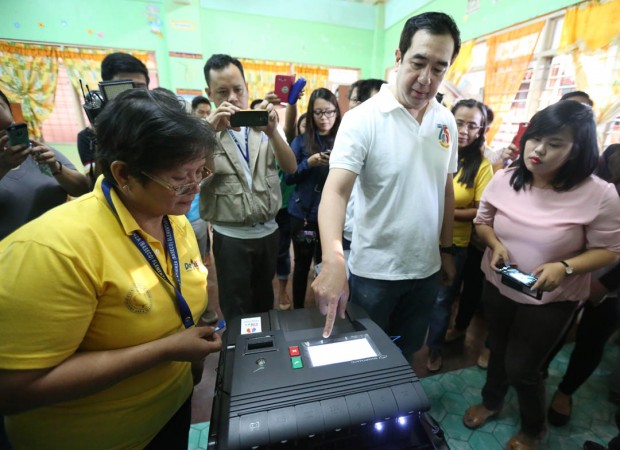The Commission on Elections (Comelec) has unanimously decided against issuing voting receipts for the May 9 elections, but it will activate on-screen verification on the vote-counting machines (VCMs).
Comelec Chair Andres Bautista, in a press briefing yesterday, said the poll body has decided against the issuance of ballot receipts after weighing its pros and cons.
“The risks outweigh the benefits,” he said, reiterating that printing ballot receipts would add two hours and 10 minutes to the voting time, not including the time it would take to replace the paper roll during voting hours, its potential to be used as a tool for vote-buying.
The Comelec also noted how the previous en banc decisions in the 2010 and 2013 elections also unanimously agreed to disallow voter receipt printing of the VCMs.
There were at least three petitions filed in the Supreme Court—including those of senatorial candidates Richard Gordon and Greco Belgica—asking the Comelec to print the ballot receipts.
Bautista said the Comelec will comply with whatever decision the Supreme Court arrives at even as it admitted that the time will be too tight for implementation.
But despite the absence of the printed receipts, the Comelec will allow voters to view the on-screen monitors of the VCMs to check the votes they have cast.
The on-screen verification will allow the voter a maximum of 15 seconds to verify via the VCM screen if the machine read the ballots correctly.
The voter has the option to extract the ballot and correct whatever shading or undervote mistakes he or she had committed.
“After weighing the risks and benefits in the use of the on-screen verification functionality, the [Comelec] has decided to err on the side of transparency, notwithstanding these attendant risks,” the Comelec en banc said in a separate resolution.
“There is a bit of a gamble on this,” said Bautista, explaining that the additional time that the feature will require voters to verify their votes is two hours and 30 minutes.
He said enabling the on-screen verification feature also carries the risks of allowing other people to take a peak on the on-screen display.
But Bautista also said risks are more easily managed with on-screen verification compared to printing receipts.
He said this decision is part of the Comelec’s effort for transparency and “to enhance the voter experience and trust and the system.”
Asked whether the additional time needed to accommodate the on-screen verification picture would force the Comelec to prolong the voting hours, Bautista said the poll body is still studying the matter.
“We will look into it … But as we said, as much as possible, we want the voting to end early,” said Bautista.
Earlier, the Comelec announced that the voting hours for the next elections will be from 7 a.m. to 5 p.m., which is shorter than the 7 a.m. to 7 p.m. schedule in 2013.


